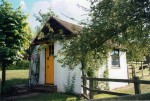 The pocket-sized brick and polystyrene shed at the bottom of Roald Dahl’s garden in Great Missenden, Buckinghamshire, is in dire need of conservation. Dahl built it in the late 50s after seeing Dylan Thomas’ writing shed and since Styrofoam was involved, obviously it was not built to last. Right now visitors can see the shed but are not allowed inside.
The pocket-sized brick and polystyrene shed at the bottom of Roald Dahl’s garden in Great Missenden, Buckinghamshire, is in dire need of conservation. Dahl built it in the late 50s after seeing Dylan Thomas’ writing shed and since Styrofoam was involved, obviously it was not built to last. Right now visitors can see the shed but are not allowed inside.
Roald Dahl’s family, including his supermodel granddaughter Sophie (the young heroine in The BFG was named after her), have launched an appeal to raise £500,000 (just short of $800,000) to restore the structure and to remove the entire inside of the hut and install it inside the Roald Dahl Museum where people can see it and it can be properly shielded from the elements. It’s a bit of a jarring thought — conserving history by peeling it out of its context — but what can you do when the context is made of Styrofoam? They moved Julia Child’s Cambridge kitchen to the Smithsonian, and that turned out pretty cool.
It is hoped the structure will be transferred to the Roald Dahl Museum and Story Centre by March next year.
The idea came from the author’s grandson, Luke Kelly, who was inspired by the relocation of artist Francis Bacon’s studio to the Hugh Lane gallery in Dublin.
Dahl’s granddaughter, Sophie, said the family wanted to share the writer’s “palpable magic and limitless imagination” with visitors.
A further £500,000 will be needed by the museum to create an interactive exhibit to set the hut in context for visitors.
The appeal has gotten some negative buzz in the press and on the Internet. The Dahl family is hardly impoverished. Roald sold a lot of books in his day, and they still sell steadily. Hearing a supermodel from a wealthy family ask for donations doesn’t sit too well with recession-struck England. According to the Roald Dahl Museum’s Amelia Foster, however, the family has already contributed a large sum and the appeal is targeted to foundations and philanthropists rather than to taking the last coins out of threadbare pockets. They’ve already raised half the £500,000 from large donors, in fact.
The legendary space in which Willy Wonka and the BFG were conceived and born has been kept exactly as Roald Dahl left it when he died in 1990. Dahl wrote all of his most famous stories in that office. He insisted it be a private space; his family were not allowed inside and even his illustrator Quentin Blake, collaborator and personal friend, only ever set foot in the shed one time.
The building was dedicated entirely to writing. There was room for a desk, a file cabinet and his beat up wingback grandpa chair which he sat it with a wooden board on this lap to write on. He had injured his back flying for the Royal Air Force in World War II (during which he also spied/slept with rich ladies for his country) so he wasn’t comfortable using a traditional office chair and desk setup.
 The desk in the room was covered with gee gaws, as was pretty much every horizontal surface, including my two personal favorites: his hip bone (the yellow sphere in the center front of the desk) and a large ball made of foil wrappers from the Cadbury’s chocolates he ate over the years (the shiny grey sphere between the rock and the grasshopper, behind the geodes). The bone, the ball of the hip joint, was sawed off from the top of his femur in a hip replacement surgery. The doctor gave it to him after the operation telling him it was the biggest one he’d ever seen. Naturally it occupies pride of place on the desk of Dahl curios.
The desk in the room was covered with gee gaws, as was pretty much every horizontal surface, including my two personal favorites: his hip bone (the yellow sphere in the center front of the desk) and a large ball made of foil wrappers from the Cadbury’s chocolates he ate over the years (the shiny grey sphere between the rock and the grasshopper, behind the geodes). The bone, the ball of the hip joint, was sawed off from the top of his femur in a hip replacement surgery. The doctor gave it to him after the operation telling him it was the biggest one he’d ever seen. Naturally it occupies pride of place on the desk of Dahl curios.
In a radio interview in 1970s, Dahl described the integral role his poky, ramshackle little shed played in his writing:
You become a different person, you are no longer an ordinary fellow who walks around and looks after his children and eats meals and does silly things, you go into a completely different world. I personally draw all the curtains in the room, so that I don’t see out the window and put on a little light which shines on my board. Everything else in your life disappears and you look at your bit of paper and get completely lost in what you’re doing. You do become another person for a moment. Time disappears completely. You may start at nine in the morning and the next time you look at your watch, when you’re getting hungry, it can be lunchtime. And you’ve absolutely no idea that three or fours hours have gone by.
You can explore the hut and find out more about its contents and Roald’s work on the Roald Dahl Museum and Story Centre website. Protip: the virtual tour didn’t work for me in Chrome but did in Internet Explorer.